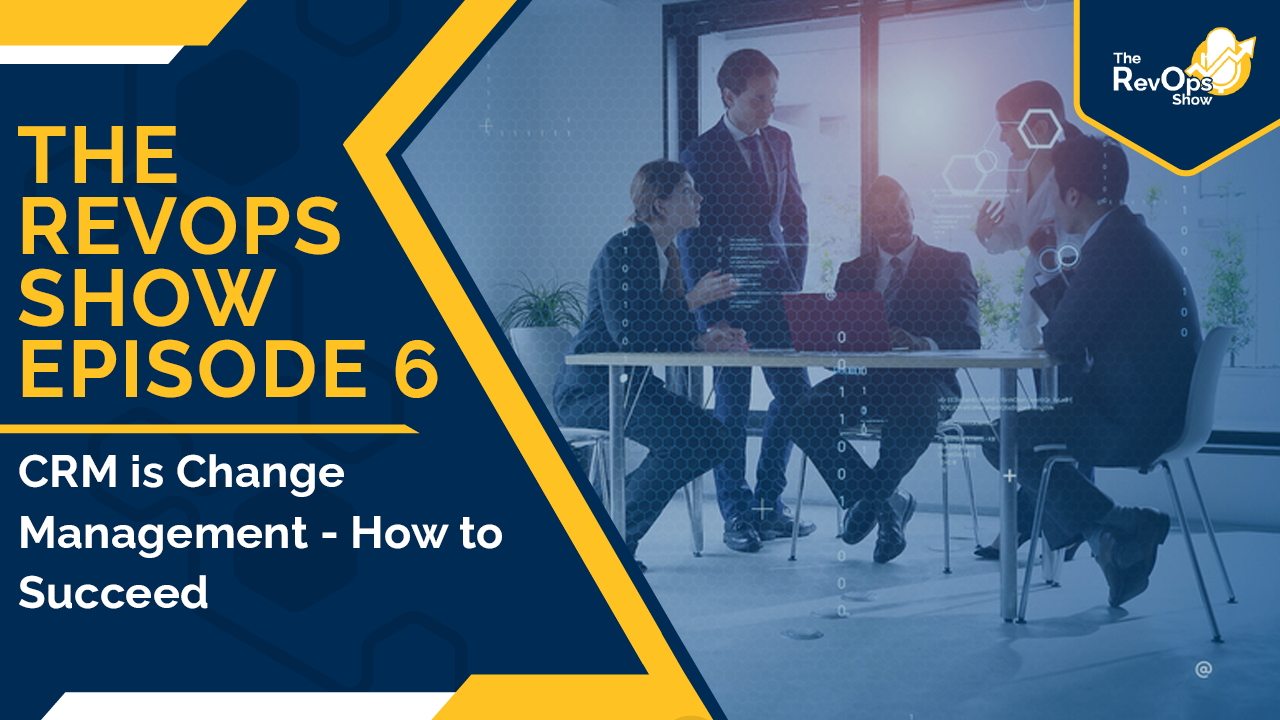Today let’s talk about the challenge of changing CRM within a sales organization; change management with a focus around if you’re switching your CRM how you can manage that with your sales team. Just the sales team/organization.
Audio:
Video:

Show Notes:
Before we get into this, let’s make one thing clear, if you change your CRM, you’re going to impact more than just your sales organizations. Today our focus is just on the sales side of things.
How have you seen most sales organizations approach change of a CRM? What is CRM in this instance? Today Jess the CRM is almost a meaningless terms because so many different people have different definitions for it. In the end a CRM is a customer relationship management database. This is one of the first mistakes people make with CRMs is they don’t define what it is or what they want it to accomplish for them.
We’ve been a part of at least 20 implementations this year and as part of our process, we do a series of deep dives because we want to make sure that we understand what’s going on. What’s the context, what’s the situation for the company? For the reps? How are things working now?
The objective in changing the CRM is never to change the CRM, but why are you changing the CRM? The only reason you’d change your CRM is that you aren’t currently getting the business results you’re looking for.
Some people switch CRMs because they’re looking for a modern CRM. What does that mean? It could mean that the systems they have don’t currently talk with one another. These types of reasons are not why you should be switching to a new CRM.
Why is it so hard for people to get the adoption that they need to get? Why is it so hard for the team to buy-in? It is until it isn’t. It’s hard because when you’re talking about something like sales, a CRM operates on algorithms, but humans operate on heuristics. There’s a lack of synchronicity between machines and people. So you have to account for that.
Another element that you have is the legacy approach. A lot of what we do, we do it because that’s how we’ve done it. The design and tech of those legacy systems built a framework; built a heuristic to how we approach things.
We can limit the conversation to just the sales organization, but we can’t limit the impact of the CRM to the sales organization because the sales organization is going to impact your operations and marketing. So if you update your CRM and no one else changes with it, your systems aren’t going to be working in alignment together.
You also have to think about how your customer is going to be impacted. How does the customer buy? How do they engage? Learn? The system is not designed the way the salesperson is working, so now you’re making the salesperson change how they behave and that originates with the customer. It’s aligning how the customer’s aligning that customer vector. Not a lot of people think about the customer when they think about their CRM system.
In sales they say always be closing. With CRM and RevOps, it’s always be mapping. That’s where the hard work is. The hard work is putting it up front so that the system can walk. It’s hard to get adoption because every time you take someone out of their routine, adoption becomes hard. It’s hard to break someone’s routine.
Let’s switch gears a little and talk about who’s the right person to drive change for sales. It might not just be one person, either. Buy-in is buy-in, though. You have to understand where the frustrations lie. You want to understand where the friction is. Someone is not going to want to change and that’s okay. Maybe they shouldn’t be here. If you have to do something different, it’s going to feel really uncomfortable at first so you’re going to get a lot of resistance. So what you do is you work on and adopt a piece of the process at a time rather than change everything in one go. Start with something that is going to make their lives easier or make them more productive. Or make it harder for them to not use the system.
Listen to the full recording for all of the hot takes. People don’t think about the sales rep when they implement CRM, but the point about people not thinking about the customer is really interesting and is not a conversation we ever hear being had when talking about CRM implementation. Every 90 days you should see greater adoption because you built more robustness into the system that enables a residual impact.
Next Steps:
-
Follow Jess, Doug & Imagine on socials for updates on the show or other insights:
-
Doug Davidoff: Twitter - @dougdavidoff | LinkedIn
-
Jess Cardenas: Twitter - @JessDCardenas | LinkedIn
-
Imagine Business Development: Twitter - @DemandCreator | LinkedIn
-
-
Subscribe to the show on Spotify & Apple Podcasts
-
Check out Let's Play RevOps on Twitch for more commentary on this topic
-
Listen to the next episode: Episode 7: Everything You Wanted to Know About Deal Desks (But Were Afraid to Ask)
